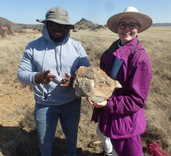 Fonda Mathalga Fonda Mathalga and Erin Lund In his 1977 thesis, James Kitching reported the discovery of a Triassic therocephalian (NMQR389) at a farm he called Oranje, in the Bethulie District. This therocephalian was subsequently re-identified by Dr. Christian Kammerer as a gorgonopsian. If the Triassic age of the outcrops is confirmed, this Triassic gorgonopsian would be an extremely rare occurence, as it would mean it survived the “Great Dying”, 252 million years ago. There are two farms in the Bethulie area that may correspond to Kitching’s Oranje: Orangia, near Donovan’s Kop in the Bethulie District, which is a wellknown Lystrosaurus Assemblage Zone locality, and Oranje in the Phillipolis District. The only things certain about Kitching’s Oranje is that its rocks have delivered many Lystrosaurus specimens and that it is located in the Bethulie District. As such, Orangia has been classically considered the same as Kitching’s Oranje; however, according to the landowner, Mr. Bertie Gobler, who gave us the warmest welcome on his farm, Oranje used to belong to the Bethulie District in Kitching’s time. Moreover, Orangia is located on Tweefontein, which is inconsistent with the fact that James Kitching (1977) provides separate entries for Oranje and Tweefontein in his thesis.
There is thus a fair chance that Oranje near Philippolis might be the original Oranje mentioned by Kitching in 1977. My students from Wits, post-doc fellow Luke Norton and myself thus travelled in August last year to Oranje to address whether this could be the locality of origin of NMQR389. Collecting fossils would quickly demonstrate if Lystrosaurus is as abundant as it is supposed to be according to Kitching’s thesis. This was the first fieldtrip for Erin and Fonda, and first time camping below 0°C temperatures for many of us, but the fossil hunt was rewarding! In the first few hours, we discovered an abundance of fossils, including large dicynodont fragments. After three days thoroughly exploring all exposures on the farm, we discovered a nice female Diictodon skull. No Lystrosaurus were recovered. This fauna supports that the farm' is fully located in the Daptocephalus Assemblage Zone which does not match Kitching’s description. The fossiliferous exposures are flat and topologically located below the Ripplemead sandstones, which are exposed on the hills of the farm (in some places, the sandstone was painted by the Khoesan). Oranje is likely not the farm that James Kitching was referring to in 1977. This fieldtrip enabled us to safely conclude that NMQR389 came from Orangia, rather than assuming so. It also provided a live experience of how the fossils can be used to date rocks in the Karoo. Moreover, given that Orangia from Tweefontein is often referred to as Oranje in the literature, this work will prevent future possible confusions between the two localities. Later on, our fieldwork at Orangia supported that both the Lystrosaurus and Daptocephalus Assemblage Zones are represented there. So whether MQR389 is a surviving Triassic gorgonopsian thus remains a mystery. More fieldwork will be needed to relocate the exact provenance of this specimen. Motivation for collection permit extension for fieldwork at Orangia, farm Tweefontein 508 (Bethulie District): Orangia is located on farm Tweefontein 508 (Bethulie District). In his 1977 thesis, James Kitching reported here the discovery of a Triassic therocephalian (NMQR389). This fossil was subsequently re-identified by Dr. Christian Kammerer as a gorgonopsian. If the Triassic age of the locality is confirmed, this Triassic gorgonopsian would be an extremely rare and worthwhile occurence, as it would mean it survived the Great Dying, 252 million years ago. In 2022, our fieldwork at Orangia supported that both the Lystrosaurus and Daptocephalus Assemblage Zones are represented there. This means that in the current state of knowledge, it is impossible to determine whether MQR389 is from the Permian, or if it is a genuine surviving Triassic gorgonopsian. To address this, more work at Orangia is needed in order to: - more precisely relocate where NMQR389 came from. Tweefontein is an expansive farm with a lot of productve exposures that remain to be explored by our team. Our work in 2022 only focused on a few selected of outcrops. - map the contact betweenthe Lystrosaurus and Daptocephalus Assemblage Zones (i.e. the Permian-Triassic Boundary) across the whole farm. References: Kitching, J.W. 1977. The Distribution of the Karroo Vertebrate Fauna: With Special Reference to Certain Genera and the Bearing of this Distribution on the Zoning of the Beaufort Beds. Published PhD Thesis, Memoirs of the Bernard Price Institute for Palaeontological Research, University Witswatersrand.
0 Comments
Leave a Reply. |
Palaeontological Society of Southern AfricaPalaeoShwe art by Sciism & Puppet Planet © 2022
|
Contact us here: |


